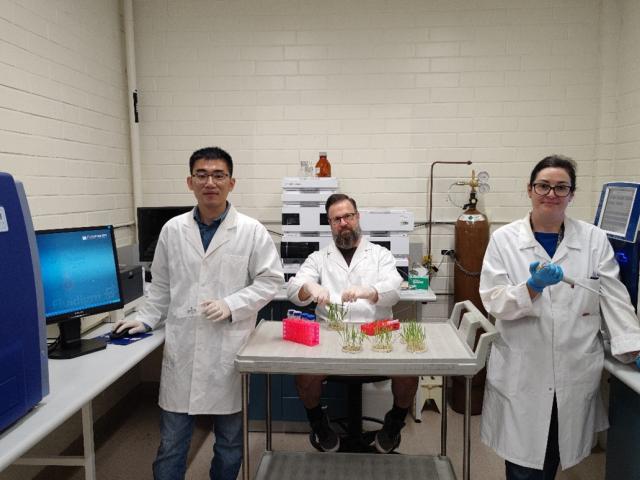Meet the Molecular Genetics team in the Genetic Improvement Portfolio
The Molecular Genetics group is adapting cutting-edge genomics, genetics and biotechnology approaches to pinpoint the genetic control of important agronomic traits and manipulate such genes to improve crop performance and resilience.
Key activities include developing gene silencing techniques for rapid gene function validation, introducing gene editing technology to Western Australia’s major grain crops for precision breeding, and using molecular markers for crop variety, purity and hybridity tests.
Headed by Senior Research Scientist Dr Yong Han, who joined the Department of Primary Industries and Regional Development (DPIRD) in April 2021, this group works closely with other researchers within the department and Western Crop Genetics Alliance at Murdoch University. Other dedicated staff include Research Scientist Esther Walker, who commenced in November 2002, and Technical Officer Julian Van Der Zanden, who joined recently in February 2024.
Gene silencing for rapid function validation
Unlocking the genetic mystery of key traits such as flowering time, nutrient use efficiency and stress tolerance in crops is always restricted due to complex genomes and lack of gene validation approaches.
Nowadays, genetic mapping can locate the regions associated with such traits, but the causal genes remain unknown, and therefore, breeders cannot use diagnostic markers for accurate selection.
The group has developed RNAi technology to induce gene silencing in wheat, barley and lupin.
Several plant virus-based vectors have been tested on different hosts and successfully applied for gene function studies.
Typically, the experiment can be completed within months, and the engineered virus can infect almost all landraces and commercial varieties.
Since the methodology is transient, it’s rapid and cost-effective compared to conventional genetic transformation approaches.
The gene silencing method was used to investigate barley Gibberellin 2-oxidase genes and revealed their diverse functions in regulating plant height, flowering time and seed size.
It’s an excellent example of showcasing how robust the technique is.
The research finding was published in the highly-ranked scientific Journal of Advanced Research in January 2024, with co-investment from the breeding company InterGrain.
Gene editing for targeted mutation creation and trait improvement
Gene editing tools like CRISPR/Cas9 have revolutionised the field of genetics, allowing scientists to make targeted changes to a genome with unprecedented accuracy and efficiency.
One of the main advantages of gene editing over traditional breeding methods is that it allows for the precise modification of specific genes, meaning scientists can target genes known to play crucial roles in stress tolerance or other desirable traits and make changes to those genes only without disturbing other agronomic characters.
Recently, the group successfully established a highly efficient and genotype-independent barley gene editing platform that allows gene targeting in Australian commercial barley varieties.
The platform has been employed to improve key agronomic traits, including nitrogen use efficiency, flowering time, plant stature, coleoptile length and seed size.
Such materials with enhanced yield potential and climate resilience are invaluable for future variety breeding and commercialisation to increase grain growers’ profitability and the industry’s sustainability.
The novel genes identified by gene editing techniques hold great potential for genetic improvements. The studies were published in highly esteemed international journals over the last few years.
The group also published review articles discussing the promise of using gene editing to improve tolerance to abiotic stresses and soil constraints in wheat and barley.
Yong was also invited to panel discussions to explore the opportunities of new breeding technologies at the 2022 AusBiotech and 2024 GRDC Grains Research Update.
Molecular markers for genetic research and breeding
Modern DNA sequencing techniques have given rise to a complete knowledge of the DNA sequences of crop cultivars.
This has allowed for a relatively small number of markers to be pinpointed that are always found in any given cultivar.
Not only variety identity but hybrids between these cultivars can also be identified.
The technique has been used in wheat and Triticale to identify individuals that are true hybrids from the crossings of various parent combinations.
These true hybrids are desirable in plant breeding and will be progressed further for doubled haploid or recombinant population production, while plants that are not hybrids but are selfings can be discarded at an early stage.
Recently, the team made another exciting application of DNA markers to identify true hybrids in a breeding program involving the forage tree Leucaena.
DPIRD breeders have successfully generated hybrid Leucaena trees that are excellent forage and sterile (unable to produce viable seeds).
This sterility is important as it will prevent this vigorous tree from becoming an environmental weed.
Once developed, it’s a reliable, rapid and cost-efficient way of identifying traits, purity, or hybridity.
Contact
Yong Han
DPIRD Senior Research Scientist
E: Yong.Han@dpird.wa.gov.au
P: 8 9360 7590

